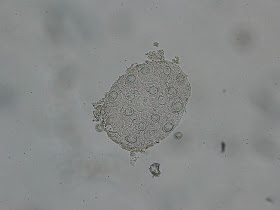Answer: Proglottids and egg packets of
Dipylidium caninum, the double-pored dog tape worm.
This small tape worm is acquired through ingestion of infected
Ctenocephalides spp. fleas, prompting one of my readers to ask if the child got infected by ingesting the specimen from the
previous case of the week! Another reader, MicrobeMan, had a similar inquiry "Was it merely coincidental that you posted
Ctenocephalides last week? Regardless, it's very appropriate, seeing as that both adult
C. canis and
C. felis can carry the cysticercoid form of D. caninum to people."
To answer these questions - it was actually a complete coincidence that we happened to have a
Ctenocephalides flea and
D. caninum proglottids submitted to my lab in such a short time period of time, and I wasn't really considering the coincidence when posting these 2 cases. So good pick up for those of you who noticed!
I like this case because it has several classic features which allow for definitive identification. The small "rice grain" sized and shaped proglottids are classic, and the egg packets that were expressed from the proglottids are diagnostic, despite being immature. Note that the material surrounding the eggs is very granular, which is something I've seen frequently when eggs are prematurely expressed from the proglottids, rather than being released naturally. So don't let that deter you from making a diagnosis if the other characteristic features such as egg packets and hooklets inside of egg-like structures are present









